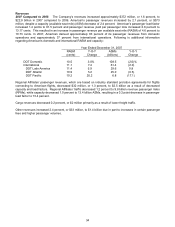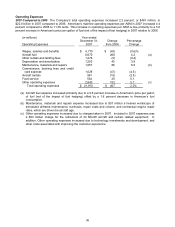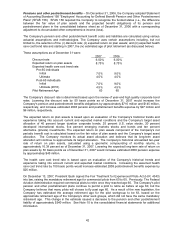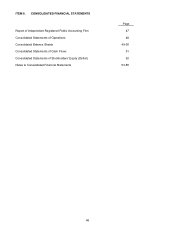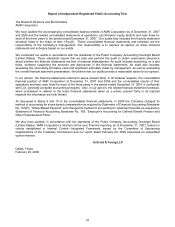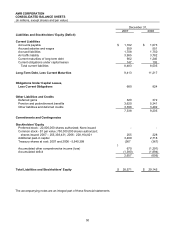American Airlines 2007 Annual Report Download - page 43
Download and view the complete annual report
Please find page 43 of the 2007 American Airlines annual report below. You can navigate through the pages in the report by either clicking on the pages listed below, or by using the keyword search tool below to find specific information within the annual report.40
Long-lived assets – The Company has approximately $19 billion of long-lived assets as of December 31,
2007, including approximately $17 billion related to flight equipment and other fixed assets. In addition to
the original cost of these assets, their recorded value is impacted by a number of estimates made by the
Company, including estimated useful lives, salvage values and the Company’s determination as to whether
aircraft are temporarily or permanently grounded. In accordance with Statement of Financial Accounting
Standards No. 144, “Accounting for the Impairment or Disposal of Long-Lived Assets” (SFAS 144), the
Company records impairment charges on long-lived assets used in operations when events and
circumstances indicate that the assets may be impaired, the undiscounted cash flows estimated to be
generated by those assets are less than the carrying amount of those assets and the net book value of the
assets exceeds their estimated fair value. In making these determinations, the Company uses certain
assumptions, including, but not limited to: (i) estimated fair value of the assets; and (ii) estimated future
cash flows expected to be generated by the assets, generally evaluated at a fleet level, which are based on
additional assumptions such as asset utilization, length of service and estimated salvage values. A change
in the Company's fleet plan has been the primary indicator that has resulted in an impairment charge in the
past.
In the fourth quarter of 2007, the Company permanently grounded and held for disposal 24 McDonnell
Douglas MD-80 airframes and certain other equipment, all 24 of which had previously been in temporary
storage. See further discussion in Note 2 to the consolidated financial statements.
All of American’s fleet types are depreciated over 30 years except for the Airbus A300 and the Boeing 767-
200. It is possible that the ultimate lives of the Company’s aircraft will be significantly different than the
current estimate due to unforeseen events in the future that impact the Company’s fleet plan, including
positive or negative developments in the areas described above. For example, operating the aircraft for a
longer period will result in higher maintenance, fuel and other operating costs than if the Company replaced
the aircraft. At some point in the future, higher operating costs and/or improvement in the Company’s
economic condition could change the Company’s analysis of the impact of retaining aircraft versus
replacing them with new aircraft.
Routes - AMR performs annual impairment tests on its routes, which are indefinite life intangible assets
under Statement of Financial Accounting Standard No. 142 "Goodwill and Other Intangibles" and as a
result they are not amortized. The Company also performs impairment tests when events and
circumstances indicate that the assets might be impaired. These tests are primarily based on estimates of
discounted future cash flows, using assumptions based on historical results adjusted to reflect the
Company’s best estimate of future market and operating conditions. The net carrying value of assets not
recoverable is reduced to fair value. The Company's estimates of fair value represent its best estimate
based on industry trends and reference to market rates and transactions.
The Company had recorded route acquisition costs (including international routes and slots) of $846
million as of December 31, 2007, including a significant amount related to operations at London
Heathrow. The Company has completed an impairment analysis on the London Heathrow routes (including
slots) and has concluded that no impairment exists. The Company believes its estimates and
assumptions are reasonable; however, given the significant uncertainty regarding how the recent open
skies agreement will ultimately affect the Company’s operations at Heathrow, the actual results could differ
from those estimates. See Note 4 to the consolidated financial statements for additional information.
Passenger revenue – Passenger ticket sales are initially recorded as a component of Air traffic liability.
Revenue derived from ticket sales is recognized at the time service is provided. However, due to various
factors, including the industry’s pricing structure and interline agreements throughout the industry, certain
amounts are recognized in revenue using estimates regarding both the timing of the revenue recognition
and the amount of revenue to be recognized, including breakage. These estimates are generally based
upon the evaluation of historical trends, including the use of regression analysis and other methods to
model the outcome of future events based on the Company’s historical experience, and are recognized at
the scheduled time of departure. The Company’s estimation techniques have been applied consistently
from year to year. However, due to changes in the Company’s ticket refund policy and changes in the
travel profile of customers, historical trends may not be representative of future results.
Various taxes and fees assessed on the sale of tickets to end customers are collected by the Company as
an agent and remitted to taxing authorities. These taxes and fees have been presented on a net basis in
the accompanying consolidated statement of operations and recorded as a liability until remitted to the
appropriate taxing authority.






